We all know the throbbing, distracting sensation in our heads brought by various kinds of triggers. There are two general categories of headaches—primary and secondary. The former type comes from certain changes to the nerves, chemicals, and blood vessels in the brain, while secondary headache is due to a head injury or infection.
There is a direct link between the location of the headache and its cause. But before we delve into what these headaches from certain spots reveal, let us first know the usual triggers:
Screen strain
Nowadays, people are spending more time with their digital devices, so the most common culprit for headaches has become digital eye strain. The blue light that computer screens emit mimics the sun and is responsible for straining the eyes. Around 50 to 90 percent of computer workers report suffering from digital eye strain and fatigued brain.
Hormonal changes
Being female has some health advantages, except when it’s about headaches, given their hormones. In fact, headaches and hormonal changes are closely correlated. Estrogen levels may fluctuate, and with this comes headaches.
Bad posture
Most of the time, the cause of our many headaches and neck pain comes from bad posture. We all are familiar with the symptoms such as tightness, dullness, and pressure in the forehead or stiffness at the back of the head or neck. These symptoms are lessened with correcting your posture.
Getting inadequate sleep and skipping meals
Missing out on meals deprives the brain of the sugar it needs to power up. On the other hand, you may notice that once you lack sleep, you wake up with a headache—migraine and tension in particular. In a 2011 study, it’s found that not getting enough sleep leads to the body’s production of proteins that cause chronic pain.
Physically dormant
One study shows that many aging-related symptoms such as tinnitus, headaches, vertigo, and more are due to being physically inactive. People who ride bikes or run on the treadmill release endorphins or the painkilling hormones and thus, experience fewer headaches.
Working out vigorously
While physical inactivity leads to headaches and other health problems, working out too hard can give off the same feel. This is because extreme workouts can inflame your head’s blood vessels. This is called an exertional headache.
Stress
A little stress can be helpful, but not when it makes you feel overwhelmed and helpless. Is your to-do list overcrowded, personal or financial issues continually piling up, or you’ve landed a demanding job? Then you’re in for tension headaches.
Dehydration
You may lose more water than you take in when you exercise vigorously, sweat, and fail to replenish the water you lost. Especially during the hot and humid summer, you may lose a lot of water just by sweating.
Medication
Some drugs like nonsteroidal anti-inflammatory drugs (NSAIDs), opioids, triptans, and caffeine may rebound. These medications may be used to relieve headaches, but using too much may only cause more headaches.

Where Your Headache Is Reveals the Type of Headache You Have
You’re better off preventing headaches when you know the triggers. Now that you do, learn about the types of headaches you might be dealing with according to their locations. This may not be a foolproof way to determine the cause, but it’s a good starting point so you can get to the problem’s root cause.
Entire head
When you feel like there seems to be a tight hairband around your head, it’s a tension headache. The pain and pressure may reach the neck then cause you to feel tenderness around your forehead. Tension headaches, in general, occur due to stress or neck problems.
Back of the head or neck
This may be due to tension headache or migraine characterized by dull, non-throbbing pain. Some people feel like their heads are squeezed. If this kind of headache usually happens to you, check your posture. Slouching can strain the muscles in the back of your head, neck, jaw, and upper back.
Temples
Again, this is caused by tension headaches, the most common among all types of headaches. You may get temporary temple headaches when you’re tired or stressed out.
On one side of the head
Migraine and cluster headaches can result in aches on one side of the head. Cluster headaches are three times more common in males. Migraines, on the other hand, will feel like an intense pulsing deep within the head.
Behind the eyes
Tension headaches and migraines remain the cause. The uncomfortable sensation on the back of or around the eyes may not necessarily feel like a throbbing ache. The pain may also be due to cluster headaches or sinus infections.
All over
When you aren’t sure which hurts because the pain seems to be all over, it may be due to tension headaches, migraines, or sinus infections, like when you get seasonal allergies.
When your headache had persisted for more than 72 hours, giving you less than 4 hours of freedom from pain, be sure to seek medical attention right away.
